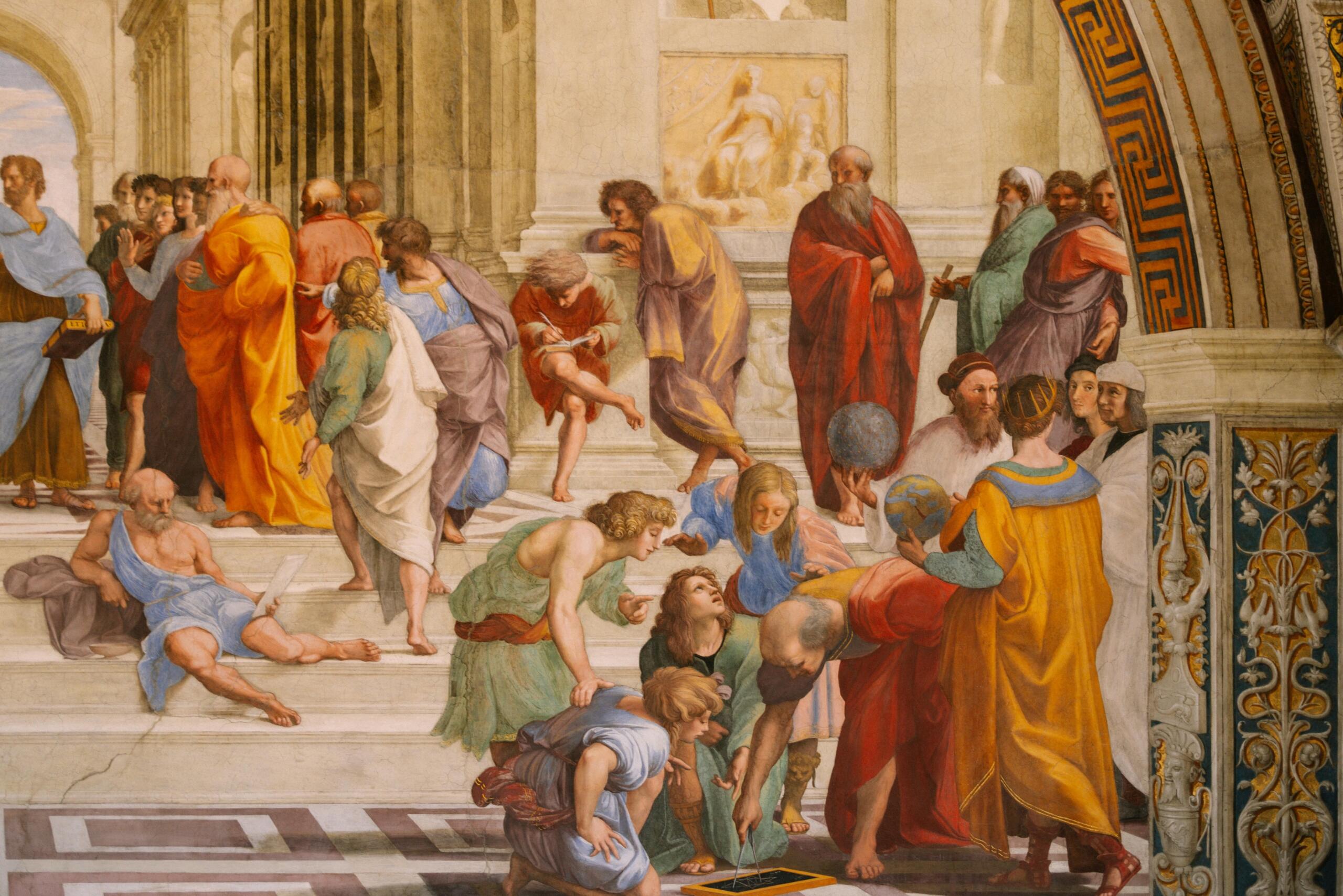Pythagoras was an ancient Greek mathematician and philosopher best known for the Pythagorean Theorem, a fundamental principle in geometry that relates the sides of a right triangle. His contributions extend beyond just one formula, his ideas laid the groundwork for topics like trigonometry, ratios, and number theory. Pythagoras' contributions to mathematics include not only the Pythagorean Theorem but also foundational work in number relationships and ratios. Even today, his influence remains deeply embedded in the math curriculum.
| Contribution | Description |
|---|---|
| Pythagorean Theorem | a² + b² = c² for right triangles, foundational in geometry |
| Pythagorean Triples | Integer solutions like (3, 4, 5) that satisfy the theorem |
| Discovery of Irrationals | Revelation that √2 is not a fraction, launching the study of irrational numbers |
| Numerology & Number Theory | Explored properties (odd/even, perfect, amicable) and symbolic meanings of numbers |
| Tetractys | A sacred 10-dot triangular symbol representing cosmic harmony |
| Five Regular Solids | Studied/contributed to the knowledge of Platonic solids (tetrahedron to icosahedron) |
| Pythagorean Tuning | Discovered simple ratios (1:2, 2:3, 3:4) in musical harmony |
| Geometry of Angles & Shapes | Established angle-sum properties of triangles and polygons |
| Cosmology & Astronomy | Taught that Earth is spherical, identified Venus as morning/evening star |
| Founding the Pythagorean School | Created a community blending mathematics, philosophy, mysticism, and treatise on numerical order (“all is number”) |

The Early Life of Pythagoras
Born on the Greek island of Samos at the end of the 6th century BCE, Pythagoras is known as one of the greatest mathematicians from antiquity. However, the elements of his history have not been completely proven, as no document from his era has survived. While some biographies that include Pythagoras’ life have been found, all were written well after Pythagoras died.

Legend has it that some months before his birth, an oracle predicted the birth of a gifted being to Pythagoras’ father. This is how Pythagoras’ name was chosen, signifying “announced by Pythian.” Just as the oracle predicted, Pythagoras proved to be a very gifted child. History tells that at just eighteen years of age, Pythagoras not only participated in the Olympic games of combat, but he won all of the competitions.
Athletic and intellectual, the young Pythagoras was interested as a scholar in Greek philosophy, history and the sciences. Some historians have also noted that he was the student of another celebrated mathematician, like Thales.
Pythagoras directly told people that he was the son of a god and that he had been repeatedly reincarnated until he reached his current form. In a past life, Pythagoras claimed, he was the son of Hermes, who had offered Pythagoras any gift he wanted except for immortality.
To continue his studies, the Greek philosopher and mathematician left on a series of journeys that would eventually lead him to Egypt. There, he strove to learn from the teachings of the Egyptian priests until 525 BCE, when the Persians invaded the country and took him as a prisoner to Babylon. There, he utilized his time to study the knowledge of the Babylonian scribes.
Once he was allowed to return to the island of Samos, Pythagoras started to teach in an amphitheater, but without much success. It was his attempts at spreading his knowledge that led to his banishment from the city.

He decided to flee to Greater Greece to fulfil his goal of creating a school, giving lectures and continuing the tradition of Greek philosophers.
Pythagoras made it a priority throughout his life to apply mathematics to philosophical thought.
How did Pythagoras contribute to math? He established the link between numbers and geometric forms, paving the way for trigonometry.
His famous Pythagorean Theorem became a cornerstone of geometry and remains widely used in mathematics and science today.
Several disciples followed him in his experiences and research with the same passion, to the point where some have argued whether Pythagoras started a sect and not a school. Pythagoras died around 500 BCE, but once again, the circumstances of his death are not well known.
The History of the Pythagorean Theorem
Pythagoras has been the bane of many middle and high schoolers' existence, with many struggling to understand Pythagoras’ most seminal concept, the Pythagorean theorem. It must come as a surprise, then, to learn that it was not discovered by Pythagoras, especially with the existence of several famous mathematicians as well.
In a right-angled triangle, the square of the length of the hypotenuse (the side opposite the right angle) is equal to the sum of the squares of the other two sides (legs). This relationship is expressed by the formula: a² + b² = c², where 'c' represents the hypotenuse and 'a and 'b' represent the other two sides.
Engraved tablets of clay, dating back to 1800 BCE, illustrate that the length of triangles and their properties were already well known to the Babylonians, way before the arrival of Pythagoras. However, the reason Pythagoras has gained credit for this theorem is that he was the first to define it in the way we still teach it today:
For right triangles with the sides a, b and c, the length of the hypotenuse can be calculated by a2 + b2 = c2.
Pythagoras
Theorizing this law led Pythagoras to be forever remembered in the annals of history. To thank the gods for having helped him in his discovery, certain accounts hold Pythagoras to have sacrificed a hundred oxen. However, it was not enough to simply form the law into existence; Pythagoras had to prove his theory.

The school founded by Pythagoras was in charge of this task, performing many experiments and calculations towards prove this theorem.
The work done by these academics inspired countless other scientists, including even the infamous Leonardo da Vinci and Sir Isaac Newton.
Without numbers, it is also possible to show the theorem like this:
The sum of the squares of the lengths of a right angle triangle are equal to the square of its hypotenuse.
Pythagoras
This formula permits the calculation of the length of one side of a right triangle, and simultaneously proves that the triangle is a right triangle. If the square of the longest side is equal to the sum of the squares of the two other sides, the triangle is a right triangle. The theorem of Pythagoras, still taught today, led to the advancement of a particular type of geometry, known as “Euclidean geometry.”

Other Important Discoveries made by Pythagoras
Why was Pythagoras important? His mathematical ideas sparked centuries of development in both abstract and applied math. Pythagoras was a veritable genius in many respects, and not just in mathematics. According to him, mathematicians should strive to learn other subjects like music, philosophy, astronomy, and mysticism. During the course of his life, he and his disciples adopted this mentality and managed to bring to light many mathematical discoveries.
Most notably, Pythagoras discovered the link between the length of a vibrating string and the pitch of the note played on that string. His investigations into music didn’t stop there; he also played with glasses containing different levels of water and found that each level of water represented a distinct musical note. These works were the basis of research for many other scientists and mathematicians, including René Descartes. His advancements in mathematics continued to permeate many different disciplines and took on many different forms.

Here are some of his most diverse discoveries. The Pythagorean spiral is a tool that allows for the geometric visualization of the square roots of consecutive whole numbers. To construct them, it is necessary to start by drawing a right triangle where the sides of the angle should be equal to 1. From this, basing the rest on Pythagoras’ theorem, the next step is to build a new triangle based on the hypotenuse of the first.
One of the sides of the right angle of the new triangle has to be on the hypotenuse of the first triangle. The other side of the angle should have the value of 1. The spiral forms by continuing the construction of the next right triangles in the same configuration as the ones preceding it. Ready to learn? Find out about our private math tutor here.
Thanks to this tool and the concept of right angles, we know the square roots of the consecutive whole numbers that are equal to the lengths of the hypotenuses of the right triangles. The Pythagorean Table of Opposites. This table is largely utilized to teach multiplication tables to kids and adults. The Pythagorean table is simple: it deals with a table containing two columns.
A Pythagorean Spiral is a series of right triangles specifically configured so that the hypotenuse of the first right triangle becomes a leg of the next right triangle. Seventeen (17) triangles are required to complete one revolution in the spiral. After 17, the triangles will begin to overlap.
In the first column, on the left, values are written. These values are multiplied, added or divided by the values to the right. The response is put on the intersection of the two values in the table. This table, utilized for multiplication, can also be used when there is a large amount of information that needs to be accounted for visually. Why not use this in your mathematics exercises to prepare for some upcoming exams?
The School of Pythagoreans in the Context of Mathematics
Pythagoras’ life goal was to teach math and to always have a group of people around him, like Archimedes, to help him in his scientific inquiries.

This is why he found, in Cortona, in the south of Italy, a school known as the School of Pythagoras.
Likened to a sect, the members of this school discussed not only science but also aimed to be astute philosophers, politicians, and even involved in religion. In general, all of Pythagoras’ life centered around mathematics.
For this school, numbers were the center of everything. Pythagoras and his disciples continued to interest themselves in the divisibility of numbers, which led to the famous proclamation: “numbers rule the universe.”
The school lasted for 150 years and is estimated to have had about 218 members, members who were known as Pythagoreans.
Because much of the work was executed as a team, it is impossible to know the exact identities of the real inventors of various formulas and principles we attribute to the Pythagorean school. They emphasized studying perfect numbers, associated numbers and sacred numbers. These latter were particularly appreciated by the Pythagoreans. For them, sacred numbers were made up of the sum of many exceptional numbers.
The number 10, for example, could represent the sum of 4 prime numbers, the sum of a pair of squared prime numbers and one perfect number, or even the sum of the first three prime numbers. Pythagoras’ disciples and Pythagoras himself were sometimes considered magicians by people in their epoque. This belief was mostly because the Pythagoreans had discovered a way to trace a regular pentagon, a figure whose five sides are equal.
To do this, the small team utilized five equilateral triangles that formed one pyramid with five faces. Once made, the scientists traced the base of the pyramid to obtain the pentagon. The pentagon that was traced by the figure was used as their symbol. The school of Pythagoreans was broken up after a dispute between two political factions within the group itself. Pythagoras and his school played a vital role in the evolution of mathematics.
It's amazing what you'll learn from taking online math courses that you mightn't from the typical classroom, right?
Whole numbers, circumferences, quadrilaterals, perpendicular, relative numbers, addition, parallelogram, decimals, sine, conjecture, scale products, fragment, diamond – all aspects of the math we learn today passed through the hand of the great mathematician.
Enhance your math proficiency with personalized tutoring services from math tutors near me: embark on a customized learning journey designed to ignite your passion for mathematics, boost your confidence, and propel your academic success to new heights!
Learn Pythagoras’ Mathematical Contributions with Superprof
If you're fascinated by the genius of Pythagoras and want to deepen your understanding of his mathematical legacy, Superprof is a great place to start. Whether you’re tackling the Pythagorean Theorem in class or exploring how his ideas connect to trigonometry, geometry, or number theory, Superprof offers access to experienced math tutors who can tailor lessons to your pace and level. With in-person or online options, students of all ages can get personalized support and gain confidence in applying ancient concepts to modern problems. For personalized guidance, consider connecting with a math tutor near me.
















